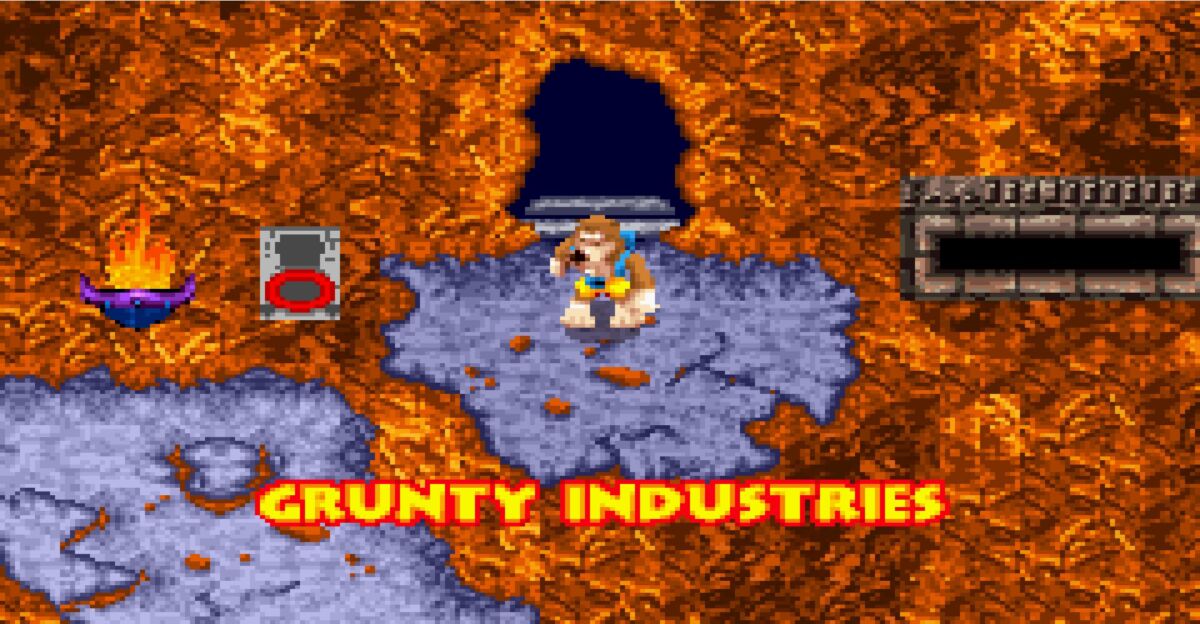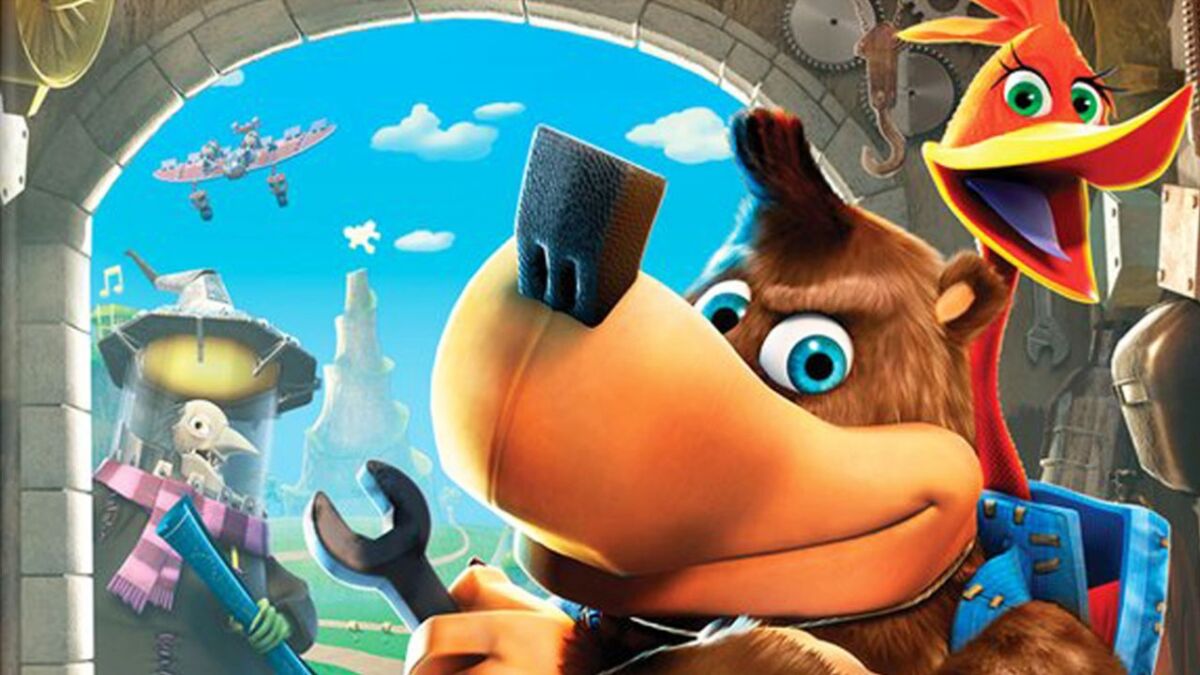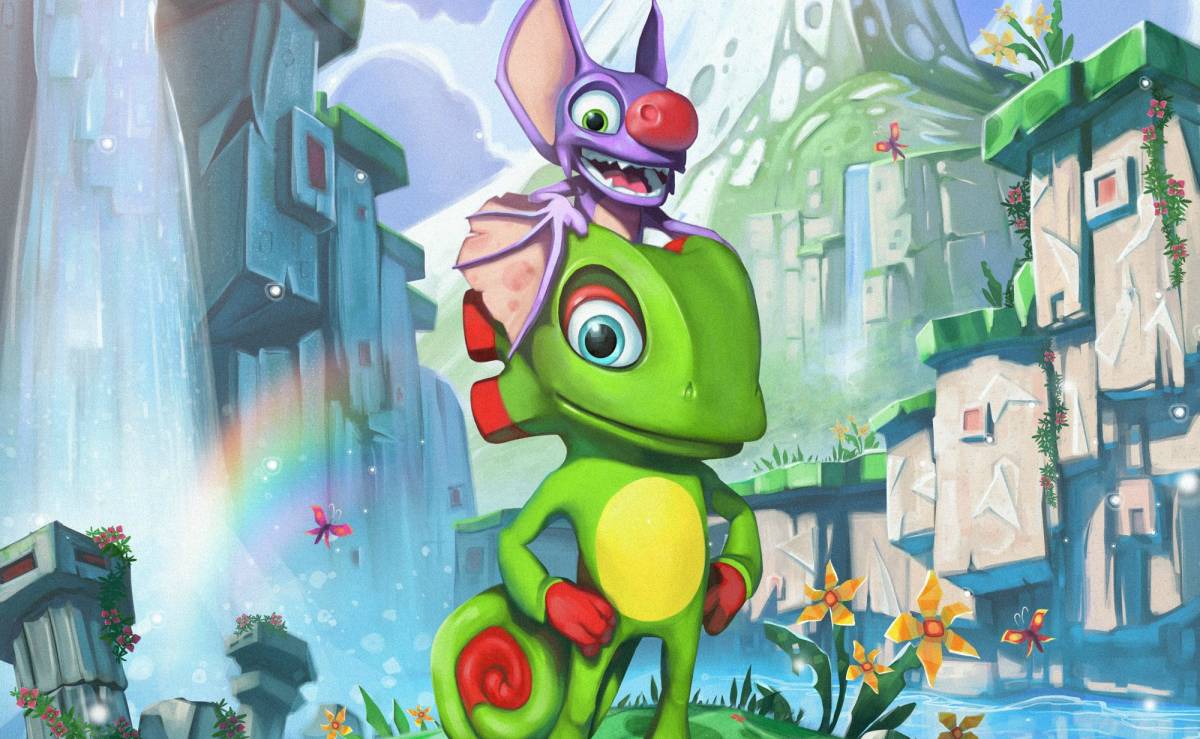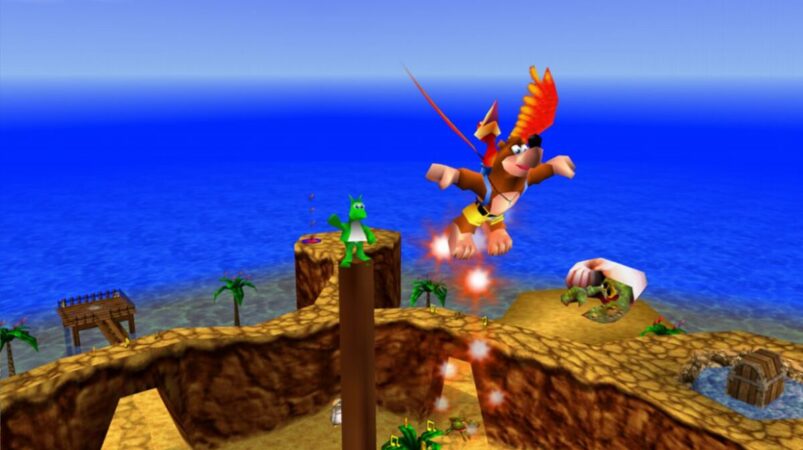There’s plenty of examples of platformer games fronted by cheerful talking animals out there – Crash Bandicoot, Earthworm Jim, Sonic the Hedgehog – but even in a genre well-stuffed with classic and beloved titles, Banjo-Kazooie is a cut above the rest. It’s not just the well-constructed gameplay, the wit and humour of the story, some world-beating soundtracks, it’s all of these things put together.
Instead of just one talking animal, eternally riffing to themselves, Banjo-Kazooie has two: a bear who’d crammed a bird into his backpack. They’re a classic yin-yang combination of opposites, with Banjo’s chummy good-naturedness offset by Kazooie’s blithe contempt for the rest of the world. They’re like the odd couple from The Odd Couple. It begs the question of how they ever became friends – and the answer, based on the gameplay, is that they represent an absolutely lethal combination. Between the two, they were capable of everything from flying to hibernating for the winter.
Here’s the history of Banjo-Kazooie.
The Originals (Banjo-Kazooie, Banjo-Tooie)

As I’ve written before, the original Banjo-Kazooie was a bit of a parody of the 3D platform game form, in particular of its Nintendo 64 neighbour Super Mario 64 – but it was the Mel Brooks kind of parody, the kind that’s done with such obvious love for what it’s parodying that it can’t help but be a pretty good example of the form itself.
The levels ran the gamut of well-worn platformer themes – desert, ice world (here with a side of Christmas), sea-side, haunted house – big, bold, familiar stuff. And likewise, the story was straight out of fairy-tale, with an evil witch having kidnapped Banjo’s sister to steal her youth and beauty. In a relic of early game design, simply saving and quitting would actually give you this bad ending, which really must be seen to be believed:
To reiterate, it showed you this every time you stopped playing.
Outside of jumping around and defeating enemies, Banjo-Kazooie was primarily a collectathon, with the game worlds full of various magical MacGuffins – the most important being Jiggies (golden jigsaw pieces that unlocked new levels) and notes (golden musical notes that unlocked new moves). It would be little more than mice running mazes to find cheese if it wasn’t for easy-on-the-eye graphics, some excellent sound design, and above all, the characterisation.
In the fanciful world of Banjo Kazooie, everything could talk back – given life by nothing more than a pair of cartoon eyeballs and some muffled sounds that passed for speech. This resulted in characters like Leaky the Bucket, Trunker the Tree, and Loggo the Toilet, most of whom needed your help with something or other (to Kazooie’s withering disgust).
Banjo-Kazooie went down a storm with the critics and the public alike. AllGame called it “raw gaming bliss”, and Gamepro went so far as to say it had surpassed Mario 64, its obvious model. As recently as 2019 – 21 years and three console generations later – it was still making lists of the best games of all time.
Two years later saw the franchise return with a sequel, Banjo-Tooie. Tooie, as you’d expect from a sequel, was aiming to be bigger and bolder than its predecessor – although this wasn’t necessarily a good thing. ‘Bigger’ was quite literal: Tooie’s overworld and individual levels were bumped up in size significantly, making the original seem rather cosy by comparison.
The issue was the same one as many sprawling game worlds – the amount of actual gameplay didn’t see an equal increase. In practice, it just meant more downtime as you went from place to place – and the developers knew this, as evidenced by them including teleporters to try and mitigate it.
Tooie also seemed to be slightly more standardised as a game. Each level now had its own distinct boss, with a title roll and everything, which made it all feel that bit more formulaic. Tooie also introduced first-person-shooter sections, which weren’t bad per se, but were somewhat shoehorned in to what was still fundamentally a platformer.
Perhaps the most exasperating part of this was adding the ability for Banjo and Kazooie to split up, a function used almost exclusively to hold down two pressure pads at once (which, of course, meant you had to make the same journey twice). It was more obviously an ‘insert tab A into slot B’ affair than the spontaneity of the original.
But despite whatever niggles you might identify, Tooie would end up outselling its predecessor – and drew similarly glowing reviews. The main point of criticism was the framerate, which feels somewhat like scraping the barrel for a negative. IGN had to admit that “aside from the technicalities, the gameplay just plain rocks”. Gamespot called it “one amazingly fun experience” and thought it might well be “one of the greatest 3D platformers ever”.
The Handheld Years (Banjo-Kazooie: Grunty’s Revenge, Banjo Pilot)

It was at about this time that the Banjo-Kazooie creators Rare, until then stalwart second-party developers for Nintendo, were bought out by Microsoft. Despite this, the next two Banjo-Kazooie games were still Nintendo titles, but found themselves restricted to the handheld Game Boy Advance after what were surely some incredibly tedious legal wrangles.
Trying to squash down a sprawling platformer like Banjo-Kazooie into handheld form inevitably had some teething troubles, although by and large Banjo-Kazooie: Grunty’s Revenge managed to pull it off. Full 3D had to give way to an overhead isometric design, but other than that, it faithfully recreated pretty much everything you’d expect from a Banjo game – bashing enemies and all the familiar elements of the collectathon.
As IGN noted, the shift backwards into 2D played merry hell with the platforming sections. The biggest bone of contention, however, was the plot, which involved time travel. This was at least partially a result of Rare straying off the reservation: they’d started work on Grunty’s Revenge before Tooie, only to be overtaken by real-life events, with this entry finally emerging in 2003 and having to slot awkwardly in-between the first two games.
Having the usually-charming plot be quite so faulty was a disappointment, but when you weren’t struggling with the viewpoint, the gameplay was more than up to snuff. Gamezone praised its learning curve, which began easy but built to a real challenge, and despite giving the game a tepid score one of Eurogamer’s main criticisms was that there wasn’t enough of it.
(And pleasingly, there is a fan project in the works to render Grunty’s Revenge into N64-style 3D.)
Because of Rare’s acquisition by Microsoft, Banjo would also end up taking the reins of what had originally been Diddy Kong Pilot, a sequel to Rare’s N64 title Diddy Kong Racing (which had actually seen an appearance from Banjo as a playable character, ahead of the release of the original Banjo-Kazooie).
Where Grunty’s Revenge was merely trying to bridge the gap to hardware that was far less powerful, Banjo Pilot had to cover a change in format – and like Diddy Kong Racing before it, it inevitably faced a lot of comparisons to the evergreen Mario Kart franchise. Particularly since, for all intents and purposes, the planes were go-karts, only rarely leaving the ground and, bizarrely, slowing down if they ever went off-road.
Cubed3 gave it a positively glowing review, calling it second only to Mario Kart. Meanwhile, Videogamer.com described it as a “deeply flawed game” and rated it a mere four out of ten – but came to the same conclusion as Cubed3, saying it was “so reminiscent of Mario Kart as to beg the question: why not just play Mario Kart in the first place?”
Now Available On Xbox (Banjo-Kazooie: Nuts & Bolts)

In 2008, Microsoft’s Xbox finally saw a Banjo-Kazooie game of its own – although more in the vein of Banjo Pilot than the originals, with the bear and bird giving up platforming in favour of riding around in customisable vehicles. And again, this shift in gameplay was divisive in and of itself.
Nuts & Bolts was actively trying to defy the collectathon gameplay of its forebears, which was by then incredibly dated. You did not need to traipse around picking up every last musical note to be able to play the game properly – instead, it brought creating vehicles and messing around with them to the forefront.
The creation aspect was roundly praised, offering a huge amount of options, but the sheer latitude provided led to problems elsewhere. Otherwise positive reviews had to admit that controlling the vehicles was incredibly fiddly – and while they tried to play it down, this did after all represent a serious flaw in what made up the majority of the actual gameplay.
Even when you got a vehicle working, the gameplay on offer was shaky at best. IGN called it “an endless procession of imagination-deficient fetch-quests, half-arsed shooting segments and three-lap races” – this last an unfortunate reminder of Banjo Pilot.
Nuts & Bolts ended up as one of those works of media better recognised for its influence, rather than as a standalone artefact. Its Lego-esque format sowed the seeds of various other construction-based titles, like astrophysics simulator Kerbal Space Program and siege engine builder Besiege.
And to date, Nuts & Bolts is the last of the true Banjo games, with the only ones since being remastered versions of the old titles for stuff like the Rare Replay compilation. But this is not the end of the story.
Wafer-thin Disguise (Yooka-Laylee)

No, Yooka-Laylee isn’t strictly a Banjo-Kazooie title – it merely proudly advertised itself as being developed by the same team, and having the same platform-based gameplay, being navigated by an unlikely animal buddy-combo named after an instrument. A more shameless spiritual sequel you could not get (except, perhaps, when another bunch of former Rare programmers took what they’d learned making the iconic FPS Goldeneye to create Timesplitters).
The Rare veterans who made Yooka-Laylee sought funding via Kickstarter, and as if to prove how fondly Banjo-Kazooie is remembered, their initial funding goal of £175,000 was reached in less than an hour. Ultimately it would raise over £2 million, becoming the highest-funded UK video game in Kickstarter history.
Yet in the end, it seemed they needn’t really have bothered. Most of the positive reviews, coming from long-in-the-tooth gaming journos, were citing the sheer nostalgia factor of playing what was essentially another Banjo-Kazooie title, and even these had to admit it was fairly uneven in content, with Destructoid noting “some areas are stunning and begged me to linger, while others looked like a tech demo”. Our own review, which began with the requisite ‘I loved Banjo-Kazooie as a kid, etc., etc.’ (a camp in which I must admit I fall) touched directly on this tension, saying “I couldn’t imagine many children being able to beat some of the later stages without the help of older siblings or parents, which raises the question of who, exactly, Yooka-Laylee is for”.
For harsher voices, the fond memories weren’t enough – indeed, they often weren’t particularly fond. Polygon reckoned “its ideas were very specific to a gameplay era that we’ve evolved past” , an assertion that’s hard to argue with given that since Grunty’s Revenge, the franchise had been casting about for something – anything – to do other than platform-based collection challenges.
To be fair, side-scrolling spin-off Yooka-Laylee and the Impossible Lair debuted to a much warmed reception. Game Informer credited it as having updated the platformer formula – the very thing the original Yooka-Laylee had failed to do.
While Banjo-Kazooie may have been in the wilderness for a while now, its legacy lives on. In 2019, Banjo and Kazooie were unveiled as the latest downloadable character(s) for Nintendo’s all-star brawler Super Smash Bros. – which might have just been to please long-time fans, but could have sparked interest in the games for a whole new audience. (It was the appearance of a couple of Fire Emblem’s anime pretty-boys in Super Smash Bros. Melee that prompted those games to be released in the West.) And most notably for the long-time fans, this was very much Banjo and Kazooie coming home.
READ MORE: Will We Ever See A New Banjo-Kazooie Game?
Some of the coverage you find on Cultured Vultures contains affiliate links, which provide us with small commissions based on purchases made from visiting our site.

